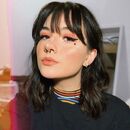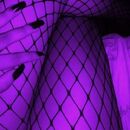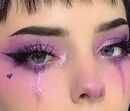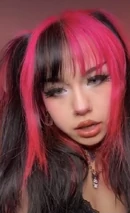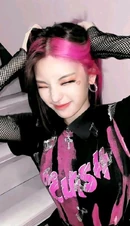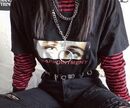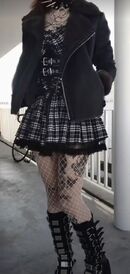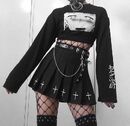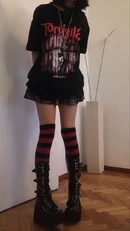Reason for Warning: Sexuality is a large part of the E-Girl identity, and the article reflects this. Some photos may be NSFW, and sex acts will be described candidly.
E-Girl, an abbreviation of "electronic girl", is a stereotype and online subculture consisting of girls who "only exist online". The conventional E-Girl takes part in anime, gaming, K-Pop, and underground alternative music circles, although enjoying all of them is not necessary. The E-Girl aesthetic is expressed through assuming an ‘alt’ persona on trending social media platforms such as Tiktok with memes and video formulas. The E-Girl is the opposite counterpart to the Soft Girl (which influences the Kawaii Gamer/pastel E-Girl subtype).
While the term E-girl first began to simply refer to chronically online women that grow an audience on social media, the stereotype is that these girls are trying to receive "clout" (internet fame) through being sexually attractive, and perhaps by posting "thirst-traps" (sexy photos) typically themed after hentai culture. There is significant overlap with the Dark subtype of the Babygirl aesthetic.
These young women are mostly from the earlier half of Gen Z. During 2020, when the aesthetic became very popular, they were mostly in their mid-teens to early 20s. E-Girl fashion has developed significant overlap with the 2020s E-Kid aesthetic, though not all E-Girls fit into this newer iteration of the subculture and E-Girls often have more of a focus on sexuality.
The classic E-Girl fashion appears very similar to Nu-Goth and Soft Grunge, but takes inspiration from various western and eastern alternative fashions as the style evolves. Many modern versions of the style appear to be a patchwork of many popular alternative fashion genres.
History[]
Due to the nature of the term, the definition of E-Girl has been constantly changing since its creation in the late 2000s. Initially used as a derogatory label for girls who engage in online gaming, it now describes a contemporary subculture. The shift in its meaning began with the rise of social media platforms, particularly Tumblr and later TikTok, which attracted a predominantly female userbase with a keen interest in gaming. Due to the proximity to gaming, many E-Girls have also become well-known through the Twitch streaming platform, where some have even turned their passion into a livelihood.
The first entry for "E-Girl" on Urban Dictionary was posted in June 2009 and was originally defined as "A guy who pretends to be a girl on online communities or games for humor or sexual meetings. Mainly 50-year-old perverts who still live with their parents".[1] This initial meaning is deeply rooted in the tongue-in-cheek adage that "there are no girls on the internet". The definition of E-Girl described young girls partaking in online spaces in unfavorable ways from 2013 through 2016.[2]
E-Girl culture and its visual motifs were influenced by multiple subcultures and trends prior to the popularization of the TikTok definition and image of the term. Many of the fashion pieces were taken from 2000s Alternative subcultures that have a greater music component. For example, fishnets and BDSM accessories, Goth and Mallgoth inspired fashion, striped socks and pleated skirts from 2014 Tumblr Soft Grunge, checkerboard and plaid from Skater, etc. One of the most direct inspirations is the tumblr Pastel Goth community, which also utilized influences from above but did not utilize ecchi imagery.
The Weeaboo/Otaku subculture, popularized in the West in the early 2000s, also was an influence. Maid uniforms, cat ears, large eyes, and blush high on cheeks are popular fashion and makeup elements in Moe and fan service in anime. Many girls also try to resemble these Moe and ecchi characters, as explained in the visuals section, which leads to overlap with the Neko aesthetic.
The current definition of E-Girl became more prevalent during 2019, with the definition of E-Girl being changed to "Girls [that] are usually teenagers and think they’re edgy. They wear long sleeves, under short sleeves, and sometimes their outfits don’t match [...] they usually wear vans, beanies, chains etc."[3] The E-Girl as an online subculture became more popular in 2019, corresponding with this change, and its aesthetic has become incredibly popular on TikTok. The E-Girl became a meme, with multiple people who are not in line with the values and hobbies of E-Girls making videos where they "try on" and parody the aesthetic. Most popular was the "E-Girl Factory" format, where a young woman begins with normal clothing, before being transformed into an E-Girl.[4]
The culture and interests of E-Girls, as well as its current popularity, can be attributed to the greater mainstream interest in things typically seen as for "nerds," such as video games, anime, and East Asian culture. In the early 2000s, people interested in these things being seen as unattractive, socially stunted, and esoteric. But as the Internet became more popular and Asian media more accessible to Westerners, the stigma dropped. However, some people in these hobby communities still differentiated themselves from the more "casual" enjoyers of the medium (e.g. an anime fan with 100+ watched vs. a person who only watched Demon Slayer). This often has a sexist connotation, as the things more popular with women were not considered the "serious" part of the hobby.
As the E-Girl trope became more popular, many adult creators utilized the components in their content. For example, these women would cosplay, pose with plushies, do the ahegao, dye their hair, etc. This is often associated with the site OnlyFans.
Philosophy[]
The most important part of E-Girl culture is the genuine passion for video games, anime, and other nerdy internet hobbies, which were traditionally dominated by men. E-Girls may develop an edgier or tomboyish persona to exist like "one of the boys". Others would utilize cutesy and nerdy feminine aesthetics, such as using a Kawaii Gamer PC, to appeal to nerdy men. These personas develop specifically for the purpose of finding acceptance or tolerance in a space that would otherwise be hostile to them, as the gamer community is infamous for its misogynistic additudes and stereotypes about female gamers.[5] Like other nerds, their focus is to become better or have more expertise in their hobbies, dedicating much of their time to video games or anime.
However, as noted by many journalists, E-Girls resemble more a persona, rather than a subculture. This means that rather than behaving a way in real life or in private, the E-Girl aesthetic and behaviors are only carried out online, such as in Discord calls, Twitch streams, or TikToks[6]. E-Girl behaviors such as making the ahegao face, behaving like an anime woman, speaking in a baby voice, or wearing uncomfortably revealing clothes run counter to behaviors in offline, non-sexual situations. Part of the E-Girl stereotype is that she directly panders to her nerdy male audience or gamer "simps" (males who act overly sympathetic to non-reciprocating women). This is often done to gain money, clout, or to simply have men buy video games for her[7].
Visuals[]
- Japanese or Korean pop culture imagery
- Kawaii mascots, especially Kuromi
- Check patterns and desaturated color palletes
- Characters and visuals from gaming culture
- Eyeliner and heavy makeup
- Alternative music scene visual trends, including those from Goth, Emo, Punk, Grunge, etc
- Neon lights
- Energy drinks and alcoholic beverages (Ex: Monster Energy, Strong Zero)
- Cursive or gothic fonts
Fashion[]
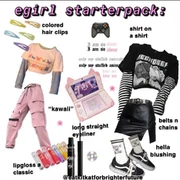
E-Girl starterpack
The E-Girl style is an aesthetic that emerged from the digital realm of social media platforms, particularly TikTok, blending influences from anime, gaming culture, and elements of 90s and early 2000s fashion. This style is renowned for its bold, expressive, and individualistic approach to fashion, celebrating self-expression, inclusivity, and online subculture. Another part of the fashion can be attributed to the high presence of Japanese pop culture on the internet. Outfits inspired by anime characters are also very common among E-Girls.
The fashion worn by E-Girls is stylistically very similar to the various darker alternative fashions. An E-Girl's wardrobe is usually characterized by oversized band tees, cargo pants, chunky shoes, and a plethora of accessories such as chains and chokers. Predominantly are printed tops in black, pleated skirts, chain accessories, chokers, and platform shoes.
Hair can range from one's natural color to vibrant hues, often accessorized with clips and beanies. It's a blend of the rebellious spirit of punk with the cuteness of kawaii culture, making a distinctive and modern statement. E-girls will often style their hair into various and trendy hairstyles such as pigtails/twintails, space buns, straight bangs or having dyed hair/streaks; accessories like hairclips or scrunchies can be added. In addition, just as much value is placed on individuality.
Makeup trends in this style often feature heavy, winged eyeliner, reddened or sickly eyeshadow with dark circles (or vibrant eyeshadow), extending the bottom of the eye with mascara, horizontal blush across the nose, and painted hearts or stars on the cheeks or near the eyes.
Media[]
This section describes the media that E-Girls interact with, rather than there being this type of aesthetic within the media.
Characters[]
- D.Va (Overwatch)
- Harley Quinn (Suicide Squad)
- Hatsune Miku (VOCALOID)
- Misa Amane (Death Note)
- Kat Hernandez (Euphoria)
- Black Lady (Sailor Moon)
- Gwen (Total Drama Island)
- Junko Enoshima (Danganronpa)
- Ramona Flowers (Scott Pilgrim)
- Raven (Teen Titans)
- Ryuko Matoi (Kill la Kill)
- Yuno Gasai (Future Diary)
- Sabrina Spellman (The Chilling Adventures Of Sabrina)
- Sam Manson (Danny Phantom)
- Himiko Toga (My Hero Academia)
- Yumeko Jabami (Kakegurui)
- Zero Two (Darling in the Franxx)
- Stocking Anarchy (Panty and Stocking with Garterbelt)
- Cat, bunny and/or maid girls in general
Influencers[]
- Belle Delphine
- Billie Eilish
- Emma Langevin
- Eve Frsr
- Grimes
- Hannah OwO
- Light Collins
- Maya Zaya
- Nava Rose
- Neekolul
- Pokimane
- Rary Kari
- RottenPapi
- Runabyte
- Xpher Wolf
- VShojo streamers
Music[]
Artists engaging in the E-Girl aesthetic include:
- Ashnikko
- Billie Eilish
- Doja Cat
- Grimes
- Various Alternative Western Music bands
- Various K-Pop or J-Pop groups
Songs[]
- "E-GIRLS ARE RUINING MY LIFE" - Corpse
- "E-Girl" - lilbubblegum ft. letoa
- "#BrooklynBloodPop!" - SyKo
- "Me!Me!Me!" - TeddyLoid ft. Daoko
- "2 Phút Hơn" (KAIZ Remix) - Pháo
- i turned a bad copypasta into a bad rap - senzawa
Activities[]
E-Girls tend to fall into Japanese otaku circles, enjoying anime media and maybe even cosplaying anime characters for conventions and outings. They may enjoy K-Pop or K-Beauty, frequenting general East-Asian media communities. In addition to eastern media, E-Girls may enjoy alternative music, becoming a part of many music-based western subcultures like Goth, Grunge and Emo. A lot of E-girls are also gamers and may be irl streamers or vtubers on Twitch or YouTube. Many E-girls can be found in Discord communities, tending to stay in each other's company without branching out into other subcultures. However, E-Girls can be found in any online community due to the broad nature of the category.
Criticism[]
Due to the popularity of East-Asian pop culture within the aesthetic, there has been an issue with "Asian fishing" with E-Girls, meaning changing one's facial features with the help of make-up in order to appesar ethnically East Asian to a degree. For example, making eyes appear more slanted with the help of eyeliner. Asianfishing, alongside their obsession with Japanese and Korean media fuels stereotypes and encourages fetishization of East Asian features and culture.
E-Girls have the added stereotype of either being generally mentally unstable or being diagnosed with a mental disorder. The stereotype depicts these women as hot but crazy, and often places E-Girls with mood disorders such as depression, bipolar, or BPD within the femme-fatale archetype. The fetishization of these women actively hinders education about the unpleasant realities of dealing with mental illness, and may push such vulnerable women into relationships that objectify them sexually due to their mental diagnosis.
Additionally is the criticism of the negative label of adult E-Girls for their edginess and sexual nature. The demonization of women who do not express themselves in a conventional manner, i.e. by engaging in niche communities or by simply developing an online persona, may be interepeted as a form of misogyny, especially due to these women being called "fatherless" for seemingly arbitrary traits such as being alternative. What may additionally be seen as misogynistic is the negative treatment and harrassment of women expressing their sexuality in any form, with women online bearing the brunt of sexual harrassment for simply showing their face, much more so for any suggestive or provocative content they may post. E-Girls are often conflated for women in the sex industry and are targeted as such, with sexual harrassment often dismissed as "coming with the territory".
Another strong point of criticism is the hyper-sexualization of teenage girls that occurs in the form of viral memes. For example, erotic dance moves from the Me!Me!Me! MV, a song based on porn addiction, became a popular trend in the late 2010s, with many of those participating being underage. The labeling of these underage girls as E-Girls is additionally detrimental for their safety due to the fact that this label inherently sexualizes them. What is also damaging is the fact that these girls have unrestricted internet access and can access such material in the first place. Unsupervised teenage girls are at high risk of being targeted for grooming by older men who abuse their developing sexuality for their personal pleasure.
Resources[]
External links to help get a better understanding of this aesthetic.
Communities[]
Vendors[]
Playlists[]
- ⚡AESTHETIC: e-girl vibes Spotify Playlist by chaotic good
- e-girl songs Spotify playlist by abstarzy
- E-Girly season 🧚🏼♀️🖤☠️ Spotify playlist by genevieve.mrvan
- e-girl tiktok songs Spotify playlist by mary caroline
- e girl vibes / 2019 tiktok Spotify playlist by Bella Comellini
- og e girl anthems Spotify playlist by zeldymusic
- e-girl shit Spotify playlist by Bug Cundiff
- F*ck With a Witch Spotify playlist by
Pinterest Boards[]
- E-Girl Gothcore by Lady
- E-Girl/Aesthetic Makeup/Style by Princess Unatainabelle 224
- Gamer ~ E-girl Aesthetic ⭐️ by west em
- E-Girls by Hannah Banana 🏳️🌈
Gallery[]
References[]
- ↑ https://www.urbandictionary.com/define.php?term=egirl&page=5
- ↑ https://www.urbandictionary.com/define.php?term=egirl&page=3
- ↑ https://www.urbandictionary.com/define.php?term=egirl
- ↑ https://knowyourmeme.com/memes/e-girl-e-boy
- ↑ https://en.wikipedia.org/wiki/Women_and_video_games
- ↑ https://www.wired.com/story/welcome-to-planet-egirl/
- ↑ https://www.wired.com/story/welcome-to-planet-egirl/

